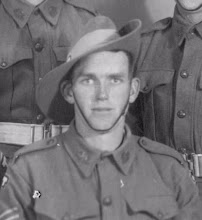The business end of a Panzer Mk IV.
This amazing photo was taken by a member of the 9th Division at Alamein in 1942. This tank is the Panzerkampfwagen MkIV, or more commonly known as the Panzer MkIV. The MkIV was a masterpiece of German engineering. It was heavily armed and armoured and with the main 75mm gun it could deliver devastating firepower quickly.
In the Western Desert campaign there was initially very little in the allied arsenal that could cause the MkIV any concern. It had 100mm thick armour that could withstand almost anything fired at it. Unfortunately for this Panzer and it's crew the troops that disabled this war machine targeted the most vulnerable part of the German tank, it's tracks. Whilst there was very little that could penetrate it's armour there was however, a number of weapons that were capable of disabling the tracks. This particular tank carries a number of sections of spare track mounted across the front of the armour plate. A machine gun (likely an MG42) is turret mounted in a forward hard point. The salvage division vultures would soon be there to take it away for further use against Axis forces.
It was tanks such as these that first probed the 9th Division's positions along the El-Adem road during the Easter Battle of 1941 at Tobruk. Around 20 tanks, including some MkIV's, approached the lines of the 2/17th Battalion and stopped approximately 30 yards from the Aussies in the defensive posts. The above photo, whist taken at Alamein and disabled, still for me conjures up a horrifying image of what it must have been like for men like my Grandfather who were the first Australians to engage the tanks of the Panzer Divisions. It was also these same men, in this same battle, that gave the allies their first ever victory over the Germans on land.
It is not a fact widely known that Australian troops of the 9th Division were the first allied troops to defeat the Germans in battle on land. The Easter Battle of 1941 at Tobruk was the first time the allies had repulsed a German attack in the war to date. The motto of the 2/17th Infantry Battalion is "What we have, we hold". On this occasion just like the many more to follow, the 2/17th held their ground and won a decisive victory against superior numbers and equipment.
image p04734.011 Australian War Memorial.









